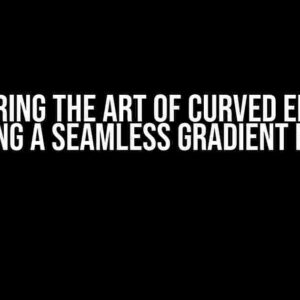If you’re working with Tailwind CSS and its grid system, you might have stumbled upon a peculiar phenomenon: children of grid divs seem to inherit certain classes, like padding and margin, from their siblings. But why does this happen, and how can you work around it?
The Mystery of Inherited Classes
To understand what’s going on, let’s take a step back and examine how Tailwind’s grid system works. When you create a grid container using `grid` or `inline-grid`, Tailwind applies a set of default styles to make the grid system work. These styles include `display: grid` or `display: inline-grid`, as well as some other properties like `grid-template-columns` and `grid-template-rows`.
Now, when you add direct children to the grid container, they become grid items. Tailwind applies some default styles to these grid items as well, including `display: grid-cell`. This is where things get interesting. Because grid items are essentially just regular elements with some special styles, they can inherit certain properties from their parent or siblings.
The Role of CSS Inheritance
CSS inheritance is a fundamental concept in CSS that allows elements to inherit certain properties from their ancestors. When you apply a style to an element, its descendants can inherit that style unless it’s overridden by a more specific rule. In the case of Tailwind’s grid system, the grid container and its grid items are all part of the same inheritance chain.
When you add a class like `px-4` (which adds horizontal padding) to a grid item, it’s not just the grid item that gets the padding – its siblings and descendants can inherit that padding as well. This is because `px-4` is a utility class that applies `padding-left: 1rem` and `padding-right: 1rem` to the element. Because these properties are inheritable, they can be passed down to other elements in the inheritance chain.
The Impact of Inherited Classes
So, what’s the big deal about inherited classes in Tailwind’s grid system? Well, it can lead to some unexpected behavior, especially when working with padding and margin.
Imagine you have a grid container with two grid items, like this:
<div class="grid grid-cols-2 gap-4">
<div class="px-4 py-2">Grid Item 1</div>
<div>Grid Item 2</div>
</div>In this example, the first grid item has a class of `px-4 py-2`, which adds horizontal padding and vertical padding. Because of CSS inheritance, the second grid item will also inherit the padding from its sibling, even though it doesn’t have the class explicitly applied.
This can lead to some weird layouts and unexpected spacing issues. For instance, if you’re trying to create a grid with equal spacing between items, inherited padding can throw off your calculations.
How to Work Around Inherited Classes
So, how can you avoid inherited classes in Tailwind’s grid system? Here are a few strategies to help you regain control over your layout:
-
Use the `!important` keyword: When you add a utility class like `px-4` to a grid item, you can add `!important` to the end of the class to prevent inheritance. For example:
<div class="px-4 py-2 !important">Grid Item 1</div> -
Use a reset class: Tailwind provides a range of reset classes that can help neutralize inherited styles. For instance, you can use `p-0` to reset the padding on a grid item:
<div class="p-0">Grid Item 2</div> -
Use a wrapper element: If you need to apply a style to a grid item, but don’t want it to be inherited, consider wrapping the content in a separate element:
<div class="grid grid-cols-2 gap-4"> <div> <div class="px-4 py-2">Grid Item 1</div> </div> <div>Grid Item 2</div> </div> -
Customize your grid system: If you’re finding that inherited classes are causing more problems than they’re worth, consider customizing your grid system using Tailwind’s configuration options. For example, you can disable the default `grid-template-columns` and `grid-template-rows` styles to regain control over your layout.
When Inherited Classes Are a Good Thing
While inherited classes can sometimes cause headaches, they can also be a blessing in disguise. In some cases, you might want grid items to inherit certain styles from their siblings or parent container.
For instance, if you’re creating a grid with a consistent spacing between items, you can apply a class like `gap-4` to the grid container and have all the grid items inherit the spacing. This can save you a lot of time and effort when working with complex layouts.
Similarly, if you’re working with a grid that has a consistent padding or margin, you can apply those styles to the grid container and have all the grid items inherit them. This can help create a more cohesive and consistent design.
Conclusion
In conclusion, the phenomenon of children inheriting their siblings’ classes in Tailwind’s grid system is a natural consequence of CSS inheritance. While it can sometimes lead to unexpected behavior, it can also be a powerful tool for creating consistent and cohesive designs.
By understanding how inherited classes work and using the strategies outlined above, you can regain control over your layout and create stunning grid-based designs with Tailwind CSS.
| Class | Description |
|---|---|
| `px-4` | Adds horizontal padding to an element |
| `py-2` | Adds vertical padding to an element |
| `p-0` | Resets the padding on an element |
| `!important` | Overrides inherited styles and applies the style to the element only |
By harnessing the power of Tailwind’s grid system and understanding the role of inherited classes, you can create incredible layouts and designs with ease.
- Understand how Tailwind’s grid system works and how it applies default styles to grid containers and grid items
- Identify the role of CSS inheritance in passing down styles from ancestors to descendants
- Use strategies like `!important`, reset classes, wrapper elements, and customization to work around inherited classes
- Leverage inherited classes to create consistent and cohesive designs
With these tips and tricks, you’ll be well on your way to mastering Tailwind’s grid system and creating stunning layouts that impress.
Here are 5 Questions and Answers about “Why do children of tailwind grid divs inherit their siblings’ classes, such as padding and margin?” :
Frequently Asked Question
Get the answers to your burning questions about Tailwind Grid divs and their quirky behavior!
Why do children of Tailwind Grid divs inherit their siblings’ classes, such as padding and margin?
Tailwind Grid divs use a utility-first approach, which means that classes are applied to the parent element and then inherited by its children. This is because Tailwind uses a pre-defined set of classes that are combined to create a consistent design system. When you apply a class like `grid` to a parent element, it sets up a grid container that contains implicit grid tracks. The children of this container then inherit the grid track properties, including padding and margin.
Is this behavior specific to Tailwind Grid or does it apply to other grid systems?
This behavior is not unique to Tailwind Grid, but rather a characteristic of CSS Grid in general. In CSS Grid, grid containers establish a grid formatting context that affects the layout of its grid items. When you apply grid properties to a parent element, its child elements become grid items and inherit the grid properties, including padding and margin. However, Tailwind’s utility-first approach makes it more explicit and easier to work with.
How can I avoid inheriting padding and margin from my grid container?
To avoid inheriting padding and margin from your grid container, you can use the `p-0` and `m-0` classes on the child elements to reset their padding and margin to zero. Alternatively, you can use the `grid-cols-1` or `grid-rows-1` classes on the parent element to prevent the grid container from establishing a grid formatting context. This will prevent the child elements from inheriting the grid properties.
What are the benefits of inheriting padding and margin from the grid container?
Inheriting padding and margin from the grid container can be beneficial for creating a consistent design system. By applying these properties to the parent element, you can ensure that all child elements have the same spacing and padding, which can improve the overall readability and aesthetics of your layout. Additionally, it makes it easier to maintain and update your design system, as changes to the grid container’s properties are automatically applied to all child elements.
Can I override the inherited padding and margin on specific child elements?
Yes, you can override the inherited padding and margin on specific child elements by applying custom classes or inline styles to those elements. For example, you can use the `px-4` class to add horizontal padding to a specific child element, or use the `mx-auto` class to center an element horizontally. By applying custom styles or classes, you can override the inherited properties and achieve the desired layout.






